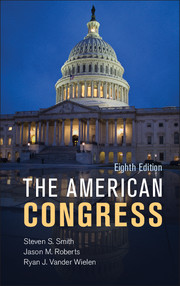Book contents
- Frontmatter
- Contents
- PREFACE
- Acknowledgments
- 1 The Troubled Congress
- 2 Representation and Lawmaking in Congress
- 3 Congressional Elections and Policy Alignments
- 4 Members, Goals, Resources, and Strategies
- 5 Parties and Leaders
- 6 The Standing Committees
- 7 The Rules of the Legislative Game
- 8 The Floor and Voting
- 9 Congress and the President
- 10 Congress and the Courts
- 11 Congress, Lobbyists, and Interest Groups
- 12 Congress and Budget Politics
- Appendix Introduction to the Spatial Theory of Legislating
- Index
8 - The Floor and Voting
- Frontmatter
- Contents
- PREFACE
- Acknowledgments
- 1 The Troubled Congress
- 2 Representation and Lawmaking in Congress
- 3 Congressional Elections and Policy Alignments
- 4 Members, Goals, Resources, and Strategies
- 5 Parties and Leaders
- 6 The Standing Committees
- 7 The Rules of the Legislative Game
- 8 The Floor and Voting
- 9 Congress and the President
- 10 Congress and the Courts
- 11 Congress, Lobbyists, and Interest Groups
- 12 Congress and Budget Politics
- Appendix Introduction to the Spatial Theory of Legislating
- Index
Summary
When the gavel fell late on the evening of Tuesday, January 1, 2013, the House had passed H.R. 8, the American Taxpayer Relief Act, otherwise known as the “fiscal cliff” deal. Despite intensive negotiations, the preceding months had failed to produce a workable agreement between the parties. Failure to reach a deal by the January 1 deadline would result in the expiration of the Bush tax cuts and the activation of punishing automatic spending cuts agreed to by Congress and President Obama in 2011. As the month of December was coming to a close, it appeared that Speaker John Boehner (R-Ohio) would be unable to hammer out a deal capable of satisfying both fellow Republicans and the administration. Many House Republicans were simply unwilling to accept a bill that included income tax raises of any sort, even on the wealthiest Americans. In fact, Boehner was forced to pull his own proposal from the House floor on December 20, 2012 – a proposal that called for tax hikes on incomes greater than $1 million – because of a lack of support from within his party. Consequently, a frustrated Boehner left the task of structuring an agreement to Senate Minority Leader Mitch McConnell (R-Kentucky). On the eve of the fiscal cliff deadline, McConnell and Vice President Joe Biden struck a deal that would temporarily ward off the fiscal cliff. In the early hours of January 1, the Senate passed the bill with broad bipartisan support. Many House Republicans, however, were unhappy with the Senate bill. Republican leaders spent hours counting votes and considering the possibility of amending the bill and sending it back to the Senate. Of course, returning an amended bill to the Senate, where it would be subject to a filibuster – the very feature that had proven to be an obstacle to reaching a deal – was far from desirable. At one point, Boehner was heard on the floor saying, “Am I having a nightmare, or what?” In the end, House Republican leaders opted against amending the bill. It subsequently cleared the House by a vote of 257 to 167, despite lacking the support of a majority of Republicans. The uneasy agreement reached by Congress and the president marked the end of a months-long legislative and political struggle.
- Type
- Chapter
- Information
- The American Congress , pp. 249 - 276Publisher: Cambridge University PressPrint publication year: 2013



